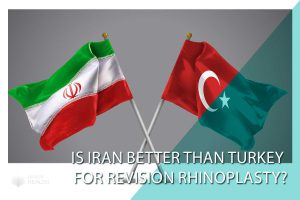Types of Nose Jobs and its Procedures
Using Rhinoplasty, you can make a wide range of cosmetic and functional adjustments, from minor to dramatic. There are unique advantages and things to consider for those seeking to improve their nose appearance and breathing capacity, from open and closed rhinoplasty to tip plasty and septorhinoplasty.
Let’s talk about this in more detail from two aspects of rhinoplasty type:
Procedural elements and types of rhinoplasty
There are different types of rhinoplasty procedures, depending on the goals and needs of the patient. Some of the common types are:
- Open rhinoplasty:
The surgeon may perform an open rhinoplasty to change the nose significantly. The procedure involves cutting across the tissue, separating the nostrils, lifting the skin of the nose, and getting to the underlying structures. Although it gives the surgeon more visibility and accuracy, it leaves a small scar and takes longer to recover. Usually, open rhinoplasty creates better results for patients who need extensive changes, like straightening a crooked nose, getting rid of a prominent hump, or refining a bulbous tip.
- Closed rhinoplasty:
This method involves making cuts inside the nose but not on the outside. So, there won’t be any visible scars, and it also takes less time to heal. But the downside is that it can only make small changes to the nose. So, closed rhinoplasty is a good option if you just need a minor adjustment, like slimming the bridge, lifting the tip, or removing a small bump.
In case you’re unsure which to choose;
Read more: Open or Closed Rhinoplasty: Which One Is for You?
- Tip plasty:
You can fix the tip of your nose without touching the rest. Depending on your desired change, you can have open or closed rhinoplasty. It can help you refine the nose tip’s shape, size, angle, and projection. Tip plasty is for those who are okay with the overall look of their nose but just want to make the tip look better.
Interested in learning more about tip plasty? Discover everything you need to know about Tip Plasty in Iran.
- Septorhinoplasty:
This surgery is a two-in-one deal. It combines rhinoplasty (nose job) with septoplasty, which fixes a deviated septum – the wall of cartilage and bone that splits your nasal cavity. If you’ve got a deviated septum, you might be having trouble breathing, snoring, or even suffering from sleep apnea. Septorhinoplasty can help you breathe easier and improve the look of your nose, too. So, consider this surgery if you’re worried about your nose’s appearance and have trouble breathing.
- Revision rhinoplasty:
Revision rhinoplasty is a secondary surgery that aims to fix the problems caused by a previous nose job that didn’t work out well or resulted in complications. It’s a bit more challenging than the first procedure because it requires dealing with scar tissue, altered anatomy, and limited cartilage. It’s perfect for people who had a rhinoplasty before but didn’t get the desired result or faced new problems after the surgery.
- Liquid rhinoplasty:
This procedure doesn’t require surgery and uses fillers to modify the nose temporarily. It can fix bumps, fill in holes, lift the tip, or balance out asymmetry. But remember that it can’t reduce the nose size or fix structural issues. Some risks are involved, such as infection, bleeding, or vascular complications. This method is best for those who want to make small changes to their nose without going under the knife or for those who want to try out how their nose would look before going for a surgical rhinoplasty.
- Ethnic Rhinoplasty:
This type of rhinoplasty is specifically designed for patients of African, Asian, Hispanic, or Middle Eastern descent. It aims to preserve their ethnic features while improving the aesthetics and function of their noses.
- Reconstructive Rhinoplasty: This type of rhinoplasty repairs noses damaged by trauma, cancer, or congenital disabilities. It may involve using grafts from other body parts to rebuild the nose.
- Reduction Rhinoplasty: This type of rhinoplasty aims to decrease the size of the nose, which may involve reducing the bone, cartilage, and skin.
- Augmentation Rhinoplasty: This type of rhinoplasty aims to increase the size of the nose, which may involve using the patient’s own tissue or synthetic implants to build up the nose.
Functional Rhinoplasty: This type focuses on improving the nose’s breathing function rather than its aesthetic appearance. It may involve procedures such as septoplasty or turbinate reduction.
Aesthetic Goals and Outcomes of Rhinoplasty
Aside from the surgical procedure, the outcome is another element of the rhinoplasty type.
Here are some typical results you can expect from a nose job that is typical around the world.
Fantasy model (Barbie/Doll nose):
This type of rhinoplasty aims to create an exaggerated, petite nose shape like a Barbie doll. The surgeon sculpts the nose into a narrow, lifted, and triangular shape, usually by reducing the nasal bones, tip, and nostrils. While it can create a “cute” nose, it risks looking unnatural. The results may not complement other facial features.
Natural model:
This aims for subtle changes to straighten and refine the nose while keeping it proportionate to the face. The goal is to correct issues like bumps or asymmetry, not drastically alter the nose shape. It results in a natural-looking nose that blends seamlessly with the rest of the face.
- A natural model with a bony nose:
This procedure reduces a prominent bony nasal bridge and comprehensive bone structure. Osteotomies and rasping refine the nasal bones for a smoother profile. The goal is to diminish the boniness while keeping the ethnic character and natural shape.
-
The natural model with a fleshy nose:
This reduces bulk and fullness, especially around a rounded nasal tip. The surgeon may remove cartilage and narrow the nostrils for definition. The aim is gently contouring a fleshy nose, controlling over-rotation, and achieving better symmetry.
Semi-fantasy model:
This falls between fantasy and natural rhinoplasty. Moderate changes are made to narrow, lift, and refine the nasal tip and bridge while retaining an elegant, graceful shape. It seeks to enhance the nose without looking obviously “done.”
In summary, rhinoplasty techniques range from fantasy to natural, depending on the desired aesthetic goals and how much reshaping is required. The key is choosing the right approach to complement the patient’s other facial features and create balanced, proportional results.
Alright, now that we’ve covered all this information, it’s time to dive into the central question of this blog post.
Discover more: Ultrasonic Rhinoplasty in Iran: Precision Redefined for Aesthetic Enhancement
Which type of rhinoplasty is right for you?
Considering all the possibilities, selecting the appropriate kind of rhinoplasty may be difficult. Here is a comprehensive guide to help you choose the right type of rhinoplasty:
Aspect 1: Procedural Elements
| Type of Rhinoplasty | Indications | Description |
| Open Rhinoplasty | Significant changes to the nose, such as straightening a crooked nose, removing a prominent hump, or refining a bulbous tip | It involves a small external incision, allowing for more precise changes to the nose’s shape |
| Closed Rhinoplasty | Minor adjustments, such as slimming the bridge, lifting the tip, or removing a small bump | Performed entirely through internal incisions, with limited visibility but less swelling |
| Tip Plasty | Refining the shape, size, angle, or projection of the nasal tip | Focuses on reshaping the nasal tip without altering the rest of the nose |
| Septorhinoplasty | Correcting a deviated septum to improve breathing and straighten the nose | Addresses both nasal form and function |
| Revision Rhinoplasty | Correcting cosmetic and functional issues from a previous rhinoplasty | Requires a specialist with extensive experience to correct previous mistakes |
| Liquid Rhinoplasty | Minor corrections, such as filling in a small depression or bump | A non-surgical approach using dermal fillers to create a new nose shape |
Aspect 2: Aesthetic Goals and Outcomes
| Aesthetic Goal | Type of Rhinoplasty | Description |
| Fantasy Model (Barbie/Doll nose) | Open Rhinoplasty | Creates an exaggerated, petite nose shape, but risks looking unnatural |
| Natural Model | Closed Rhinoplasty or Tip Plasty | Aims for subtle changes to straighten and refine the nose while keeping it proportionate to the face |
| Natural Model with a Bony Nose | Open Rhinoplasty | Reduces a prominent bony nasal bridge and wide bone structure |
| Natural Model with a Fleshy Nose | Closed Rhinoplasty or Tip Plasty | Reduces bulk and fullness, especially around a rounded nasal tip |
| Semi-Fantasy Model | Open Rhinoplasty or Tip Plasty | Falls between fantasy and natural rhinoplasty, making moderate changes to narrow, lift, and refine the nasal tip and bridge |
So, How Can I Choose Between Nose Job Shapes?
Based on the above table, Choosing the right type of rhinoplasty is a personal decision that depends on your goals, desired outcome, and facial features. Here are a few factors to consider when deciding on a nose job:
- Natural vs. enhanced look: Do you want subtle improvements that look natural or more dramatic reshaping? Keep in mind that overdone results can look artificial.
- Nose characteristics: What are the specific issues you want to change (hump, drooping tip, wide nostrils, etc)? This will determine the techniques needed.
- Facial harmony: Consider how your current and desired nose will balance with your other facial proportions.
- Ethnic background: Make sure the nose complements your heritage. An experienced surgeon can recommend approaches to maintain ethnicity.
- Revision vs. primary: Is this your first rhinoplasty or a revision? Revision techniques are more complex.
- Lifestyle: Your activities and profession may dictate functional considerations.
- Budget: Some techniques are more expensive. Make sure your expectations align with your budget.
Important note:
Take time to consult with an experienced board-certified plastic surgeon carefully. Communicate your cosmetic goals, share photos, and listen to their expert guidance on suitable options. Doing your research is vital to finding the best rhinoplasty for your needs and aesthetics.
Rhinoplasty costs in 2024 based on different types:
We discussed your budget at the final point of deciding on your Rhinoplasty type; it’s not too awful to compare the costs of the various options to Clear your head.
| Type of Rhinoplasty | Iran | Turkey | US |
| Primary Rhinoplasty | $1,500 – $3,000 | $2,000 – $4,000 | $5,000 – $10,000 |
| Revision Rhinoplasty | $2,500 – $5,000 | $3,500 – $6,000 | $8,000 – $15,000 |
| Tip Plasty | $1,000 – $2,000 | $1,500 – $3,000 | $3,000 – $6,000 |
| Septorhinoplasty | $2,000 – $4,000 | $3,000 – $5,000 | $6,000 – $12,000 |
| Open Rhinoplasty | $2,500 – $5,000 | $3,500 – $6,000 | $8,000 – $15,000 |
| Closed Rhinoplasty | $1,500 – $3,000 | $2,000 – $4,000 | $5,000 – $10,000 |
| Liquid Rhinoplasty | $500 – $1,500 | $1,000 – $2,500 | $2,000 – $5,000 |
| Ethnic Rhinoplasty | $3,000 – $6,000 | $4,000 – $8,000 | $10,000 – $20,000 |
| Reconstructive Rhinoplasty | $4,000 – $8,000 | $5,000 – $10,000 | $12,000 – $25,000 |
Additional Costs:
- Hospital stay: $500 – $2,000 (depending on the country and hospital)
- Anesthesia: $500 – $2,000 (depending on the type and duration)
- Medications and follow-up care: $500 – $1,000 (depending on the country and clinic)
- Travel and accommodation (for international patients): $1,000 – $5,000 (depending on the country and duration of stay)
Note: The prices are approximations and could change according to the particular clinic, surgeon, and region. Although price is important, when selecting a rhinoplasty surgeon and clinic, your safety and the standard of treatment must come first.
Non-surgical option for Rhinoplasty
We have only discussed nose job surgery so far, but if you want to change your nose shape, you have another option: non-surgical alternatives.
Some people may not be ready or willing to undergo surgical rhinoplasty despite its long-term effects. Fortunately, non-surgical treatments can produce effects that last from momentary to semi-permanent. The following are some non-surgical rhinoplasty options:
- Dermal Fillers: Hyaluronic acid-based fillers (e.g., Juvederm, Restylane) can add volume, smooth out bumps, and refine the nasal tip.
- Botulinum Toxin (Botox): Botox can relax the nasal muscles, reducing the appearance of a droopy or bulbous tip.
- Nasal Contouring with Threads: Involves inserting thin, dissolvable threads under the skin to lift and contour the nose.
- Radiofrequency (RF) Treatment uses heat energy to stimulate collagen production, tighten the skin, and improve nasal contours.
- Nasal Shaping with Fat Transfer: This involves transferring fat from one body area to the nose to add volume and shape.
- Nasal Contouring with Platelet-rich Plasma (PRP): This procedure uses platelet-rich plasma (PRP) to stimulate collagen production and improve nasal contours.
We recommend reading more about Surgical Rhinoplasty vs. Non-Surgical Rhinoplasty, to learn how to choose between the two.
Final Thought
The decision to undergo rhinoplasty is a collaborative journey between you and your chosen surgeon.
Even though you bring your ideal cosmetic objectives, the surgeon’s specialty is evaluating your particular face shape, past medical history, and general fitness for the operation. A qualified rhinoplasty surgeon will thoroughly evaluate your nose, listen to your problems, and advise you on the best approach to get balanced, natural-looking results that enhance your attractiveness. Recall that the most excellent surgeons prioritize patient safety and reasonable expectations during the procedure. Working together, you and your surgeon may produce a nose that improves your look and increases your confidence with open communication and the same goal.
Schedule a Free Consultation with us
During your rhinoplasty procedure, we are by your side from airport to airport to say goodbye; what exactly does this mean:
- At IranHealthAgency, we’re committed to providing a unique and personalized medical tourism experience.
- Our “airport to airport” service means that we’ll be with you every step of the way, from Arrival and airport transfers
- Pre-operative consultations and preparations
- Accommodation and hospitality services
- Surgery and post-operative care
- Recovery and sightseeing activities
Trust us to take care of all the details so that you can focus on your health and well-being.



